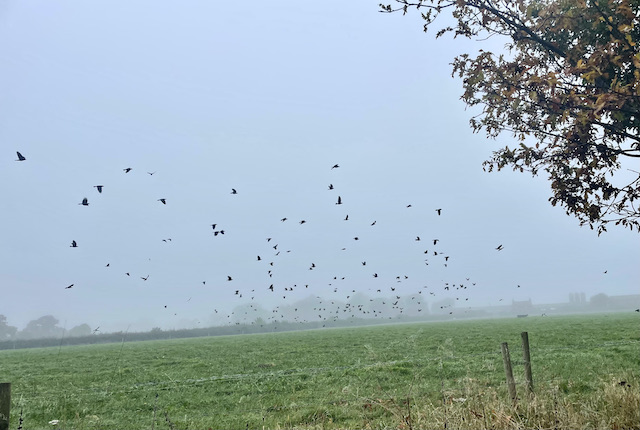It’s a misty autumn morning and I’m getting out for my first long run since the Yorkshire Marathon, just under two weeks ago. There’s hardly any wind and I’ve picked a route that isn’t too hilly, which is good because I’m attempting to keep my heart beating at around the 135 mark.
Ever since I was given this posh watch for my birthday, I’ve been slightly obsessed with my heart rate when running, and really surprised that, what I thought of as a slow run, wasn’t in Zone 2. Most of the time, it wasn’t even in Zone 3, which just goes to show that I don’t have that much range.
Let me back track a little and explain, as it’s pretty new to me.
Someone, somewhere, has decided to divide the heart rate range into five zones, where Zone 1 would be ‘live long and prosper’, and Zone 5 is ‘it cannae take anymore Captain, she’s gonna blow’. Sorry, had a moment there. From an easy walk to a flat out 50 metre dash. Zone 2 is apparently the point where lots of fantastic physiological things are happening to your body but you are not putting it under stress.
Things such as more mitochondria. They are the tiny batteries that run your cells, and if you have more batteries, you’ve got more power. It also increases and strengthens blood vessels and capillaries , making your whole aerobic ability more efficient, so that, over time, your Zone 2 pace should start speeding up (fingers crossed). Your recovery time and likelihood of injury are also massively reduced by this type of running.
Colin, from the club, recently began setting up Zone 2 running sessions. I’ve only been on one since getting my Garmin, and failed miserably at it. I went too fast, trying to keep up with the person in front [note to self: learn the route beforehand next time].
Today, I am really doing my best to stay within my Zone 2 range, and it is beginning to feel just about manageable. As the crows in the field next to me are agitatedly cawing, I’m finally in a kind of a rhythm, of very small steps. It had been feeling incredibly slow for the first half hour but I’ve found that this is the zone where I can easily breathe with my mouth closed for the vast majority of time (give or take a few snot bombs – or, if you’re more genteel, a blow or two into a handy tissue). In fact, if you don’t have any high tech gizmos, then being able to breathe comfortably through your nose is probably as handy a measure as anything. And I don’t mean for about three or four breaths before you need to gasp. At this level of effort, nasal breathing is really comfortable.
So where has this number of 135 come from? Colin gave me a really easy way to calculate it roughly.
180 – your age (with a plus or minus 5 for the range).
So for me it is:
180 – 50 = 130
The Marathon Handbook has a more complicated calculation but it takes sex into account, as well as age. They take Zone 2 to be 60-70% of your maximum heart rate, and they use the following formulae to work out what that maximum should be:
Max HR for Males = 208.609 – (0.716 x age)
Max HR for Females = 209.273 – (0.804 x age)
Then you need to work out your Heart Rate Reserve (HRR) which is your Max HR minus your Resting HR (when you’re sitting doing nothing for a while).
Finally you get your range by doing the following calcs:
Lower end = (0.60 x HRR) + Resting HR
Upper end = (0.70 x HRR) + Resting HR
Highly complicated sounding but I had a go with mine.
My Max HR:
209.273 – (0.804 x 50)
209.273 – 40.2 = ~169
My Resting HR is around 69 so my HRR is a handy 100 and
my range is:
LE = (0.6 x 100) + 69 = 129
UE = (0.7 x 100) + 69 = 139
So Colin’s way of doing it was in a similar ball park, and was a lot easier to work out but with this calc, the 135 is in the middle instead of the top end, which is easier for me to manage.
Although my breathing is exceedingly comfortable, my legs are surprisingly tired as I get close to the end of my allotted two hours. I’ve managed just short of 8.5 miles in that time, whereas I’d do 10 miles fairly comfortably normally. It does feel a little counter-intuitive running at this pace. My running week will get longer if I do the recommended 60-75% of my weekly mileage in this zone. I am going to try it though, for a while, as I want to see if my pace does improve.
One thing I do have to do for these runs, however, is to dig out my gloves, as I’m generating hardly any heat, and my fingers are flippin’ freezing.


Proper science! I too have just started running with a clever watch – I was surprised to see that my heart rate on hard hill reps was just under 120 – I’m wondering if I’m working as hard as I think I am.
Wow, just shows how aerobically efficient you are! I have a way to go to reach that
… or just slow